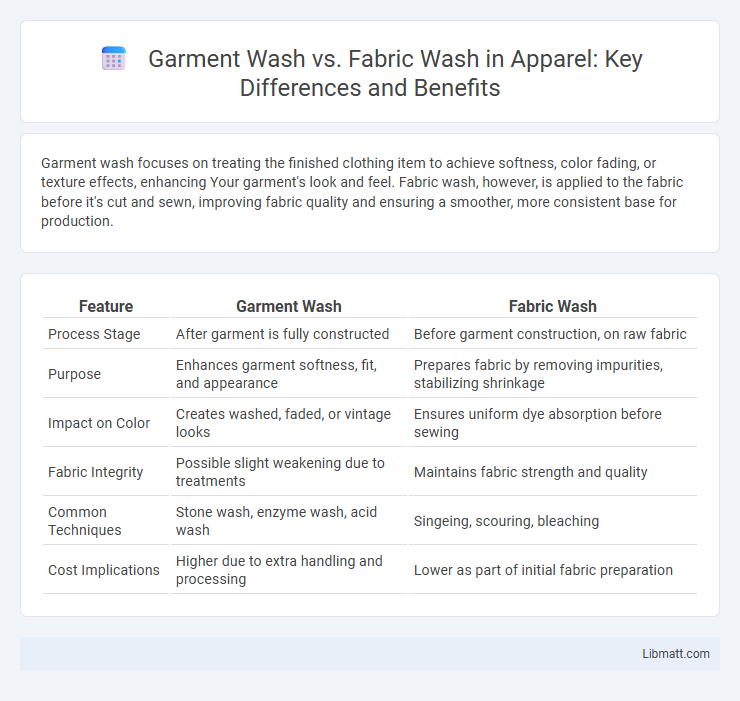Garment wash focuses on treating the finished clothing item to achieve softness, color fading, or texture effects, enhancing Your garment's look and feel. Fabric wash, however, is applied to the fabric before it's cut and sewn, improving fabric quality and ensuring a smoother, more consistent base for production.
Table of Comparison
| Feature | Garment Wash | Fabric Wash |
|---|---|---|
| Process Stage | After garment is fully constructed | Before garment construction, on raw fabric |
| Purpose | Enhances garment softness, fit, and appearance | Prepares fabric by removing impurities, stabilizing shrinkage |
| Impact on Color | Creates washed, faded, or vintage looks | Ensures uniform dye absorption before sewing |
| Fabric Integrity | Possible slight weakening due to treatments | Maintains fabric strength and quality |
| Common Techniques | Stone wash, enzyme wash, acid wash | Singeing, scouring, bleaching |
| Cost Implications | Higher due to extra handling and processing | Lower as part of initial fabric preparation |
Introduction to Garment Wash and Fabric Wash
Garment wash refers to the process applied to fully constructed clothing to enhance texture, color, and softness, often involving techniques like stone washing or enzyme washing. Fabric wash, on the other hand, is performed on raw fabric before garment construction to improve hand feel, remove impurities, and achieve desired colorfastness. Understanding the distinction between garment wash and fabric wash is crucial for optimizing production quality and garment performance.
Key Differences Between Garment Wash and Fabric Wash
Garment wash involves treating the entire finished garment to achieve specific textures, colors, or softness, whereas fabric wash is applied to the fabric before garment construction to modify the material's properties. Garment wash allows for detailed, localized effects like distressing or fading on seams and pockets, while fabric wash ensures uniform treatment across the fabric surface. The primary difference lies in the timing and scope of treatment--garment wash enhances the final product's aesthetic post-assembly, and fabric wash prepares the raw material for consistent performance and appearance during manufacturing.
Understanding Garment Wash: Process and Purpose
Garment wash involves treating fully constructed clothes to enhance softness, color intensity, and texture, often using enzymes, chemicals, or abrasion techniques. This process improves the final garment's appearance and comfort, setting it apart from fabric wash, which occurs before the garment is assembled. Understanding garment wash helps you select apparel with desired durability, feel, and aesthetic qualities tailored to your preferences.
What is Fabric Wash? Methods and Techniques
Fabric wash refers to the process applied to raw or partially processed fabric to remove impurities, improve texture, and enhance color vibrancy before garment construction. Common fabric wash methods include enzyme wash, stone wash, bio-polishing, and softener treatment, each targeting specific fabric characteristics such as smoothness, shrinkage control, and color brightness. These techniques optimize fabric quality, durability, and comfort, playing a crucial role in the textile manufacturing workflow.
Effects on Fabric Quality and Durability
Garment wash primarily affects the entire finished product, enhancing softness and appearance while potentially reducing fabric tensile strength due to abrasion and chemical exposure. Fabric wash targets raw fabric before garment construction, improving dye fastness and removing impurities, which preserves long-term durability more effectively. Studies show that excessive garment washing can lead to increased fiber breakdown, whereas controlled fabric washing maintains structural integrity and extends fabric lifespan.
Impact on Color, Texture, and Appearance
Garment wash significantly alters the color, texture, and appearance by softening fabric and creating a worn-in, vintage look through techniques like stone washing and enzyme washing. Fabric wash primarily targets fabric before construction, enhancing its texture and color uniformity but resulting in a more consistent, less distressed finish. The choice between garment wash and fabric wash depends on the desired final aesthetic, with garment wash offering more pronounced variations in texture and appearance.
Cost Implications: Garment Wash vs Fabric Wash
Garment wash typically incurs higher costs due to the process being applied to finished products, requiring more labor, water, and energy compared to fabric wash, which treats raw fabric before garment construction. Fabric wash offers cost savings by enhancing fabric quality early, reducing defects and rework during production, whereas garment wash adds value through customized finishes but with increased operational expenses. Understanding these cost implications helps you choose the most efficient washing method aligned with your budget and production needs.
Sustainability and Environmental Considerations
Garment wash processes typically involve treating finished clothes, often using large volumes of water and chemicals that can generate significant wastewater, posing environmental challenges if not properly managed. Fabric wash refers to pre-treatment of raw or semi-processed textiles, allowing for more controlled and efficient use of water and eco-friendly detergents, reducing the overall environmental footprint. Sustainable practices in both processes include adopting water recycling systems, using biodegradable chemicals, and minimizing energy consumption to lower the impact on ecosystems and conserve resources.
Industry Applications and Use Cases
Garment wash involves treating fully constructed clothing to enhance texture, color, and softness, widely used in fashion retail to create distressed or vintage looks. Fabric wash is applied to raw textile materials before garment assembly, improving dye absorption and fabric hand feel, crucial in textile manufacturing for quality control. Both processes are essential in apparel production, with garment wash targeting finished styles and fabric wash focusing on material preparation.
Choosing the Right Wash for Your Needs
Selecting the right wash involves understanding the differences between garment wash and fabric wash, as garment wash processes finished clothes to enhance texture and appearance, while fabric wash treats raw textiles before cutting and sewing. Your choice depends on desired effects such as softness, colorfastness, or vintage looks, with garment wash offering more customization on completed products and fabric wash providing uniform treatment on materials. Evaluating factors like fabric type, end-use, and cost helps ensure the wash aligns perfectly with your production goals and product quality.
Garment Wash vs Fabric Wash Infographic

 libmatt.com
libmatt.com